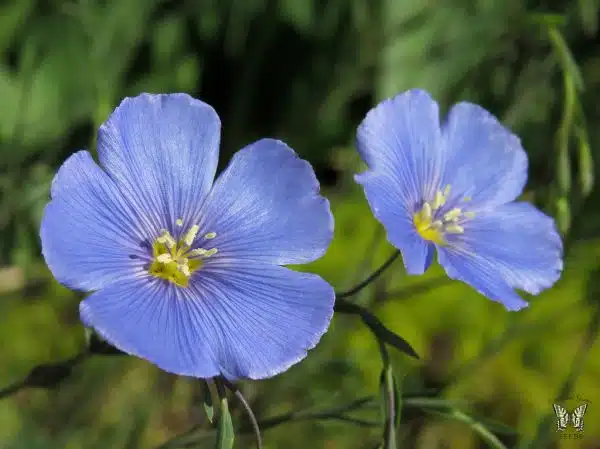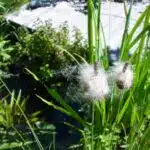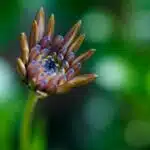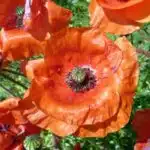Flax flowers, also known as Linum usitatissimum, are a beautiful addition to any garden or landscape. These delicate and vibrant blooms are not only aesthetically pleasing but have a rich history of providing fiber for clothing and linseed oil for various industrial uses. However, growing and caring for flax flowers can be a daunting task if one is unfamiliar with their specific needs and requirements.
As horticulturalists and plant care specialists, it is our duty to provide valuable information on the cultivation and maintenance of flora. In this article, we will delve into the world of flax flowers – exploring their origins, ideal growing conditions, and maintenance practices. By following these guidelines, you can successfully grow and care for flax flowers in your own garden or landscape while contributing to the preservation of this historic plant species.
The History And Significance Of Flax Flowers
Flax flowers, also known as linum, have been cultivated for thousands of years for their fiber and oil. These plants are native to the Mediterranean region but are now grown worldwide in temperate climates. Flax flower cultivation has been recorded in ancient civilizations such as Egypt, where it was used for mummification, and in China, where it was believed to have medicinal properties.
Apart from its practical uses, flax flowers hold significant symbolism across different cultures. In Christian tradition, the blue flax flower symbolizes purity and innocence. The plant is also associated with rebirth and renewal due to its ability to self-seed and grow anew each year. In Celtic mythology, the flax plant was seen as a symbol of wealth and abundance.
Today, flax flowers continue to be valued not only for their symbolism but also for their aesthetic value in gardens. With proper care and attention, these delicate blooms can be enjoyed throughout the summer months. Understanding the anatomy of the flax flower is crucial in ensuring that they thrive in your garden or landscape setting.
Understanding Flax Flower Anatomy
The intricate history and cultural significance of flax flowers have been explored in the previous section. However, to truly appreciate these delicate blooms, one must first understand their anatomy. Flax flowers come in a range of colors, including blue, pink, and white. Their petals form a delicate cup shape that surrounds the reproductive organs.
The pollination process for flax flowers varies depending on the species. Some types are self-pollinating, while others rely on insects like bees and butterflies to transfer pollen from flower to flower. Regardless of how they are pollinated, successful fertilization leads to seed production and the continuation of this beautiful plant species.
When considering growing and caring for flax flowers, it is important to choose the right location for optimal growth. These plants thrive in well-draining soil with plenty of sunlight exposure. Additionally, they prefer slightly acidic soil conditions with a pH range between 5.5 and 6.5. By providing these favorable conditions and proper care, gardeners can enjoy the beauty of flax flowers year after year.
Transitioning into the subsequent section about choosing the right location for your flax flowers: With an understanding of flax flower anatomy and pollination processes established, it is time to delve further into growing these stunning blooms by exploring how to choose the ideal location for them to thrive.
Choosing The Right Location For Your Flax Flowers
Location selection is crucial for the growth and development of flax flowers. Flax requires full sun and a well-drained soil that is rich in organic matter. Therefore, it is important to choose a location that receives at least 6-8 hours of direct sunlight daily. The ideal location should also be sheltered from strong winds, which can damage the delicate stems of young plants.
When selecting a location for your flax flowers, consider the overall aesthetic of your garden or landscape design. Flax flowers are versatile and can be used as borders or accents in flower beds, rock gardens or along walkways. They can also be grown in containers on patios or balconies to add color and texture to outdoor living spaces.
To ensure optimal growth of your flax flowers, prepare the soil properly before planting. Start by removing any weeds or debris from the planting area. Next, test the soil pH level to determine if it falls within the range of 6-7. If necessary, amend the soil with compost or other organic matter to improve its texture and nutrient content. Proper soil preparation will provide a strong foundation for your flax flowers and promote healthy growth throughout their life cycle.
Now that you have chosen an ideal location for your flax flowers, it’s time to prepare the soil for optimal growth!
Preparing The Soil For Optimal Growth
Choosing the right soil for flax flowers is essential for optimal growth, as different types of soil will provide different levels of nutrition for the plant. When selecting soil for flax flowers, it is important to pick a soil that is light and well-drained. Additionally, soil should be enriched with organic matter for optimal growth. Adding nutrients to the soil can also help to provide an optimal growing environment for flax flowers.
Choosing The Right Soil
When it comes to growing flax flowers, one of the most important factors is ensuring that the soil is prepared for optimal growth. The first step in this process is choosing the right soil. Flax flowers prefer well-draining soil with a sandy or loamy texture. The ideal soil composition should be light and crumbly, allowing for proper oxygenation and water retention.
Another crucial factor in preparing the soil for flax flowers is understanding pH levels. These plants thrive in slightly acidic to neutral soils with a pH range between 6.0 and 8.0. To determine your soil’s pH level, you can purchase a testing kit from your local garden center or send a sample to a laboratory for analysis. If your soil’s pH level is too low, you can add lime to raise it, while if it’s too high, adding sulfur can lower it.
Lastly, when selecting soil for flax flowers, it’s essential to consider the location where they will grow. If planting in an area with heavy rainfall or near bodies of water, ensure that the soil has good drainage capabilities to avoid waterlogging and root rot. Additionally, if planting in an area with poor quality soil, consider amending it with organic matter such as compost or peat moss to improve its nutrient content and overall quality. By selecting the right type of soil and understanding how pH levels affect growth, you can ensure that your flax flowers thrive and produce beautiful blooms year after year without fail.
Adding Nutrients
To ensure that flax flowers grow optimally, it’s important to prepare the soil by adding nutrients. One effective way to do this is through composting. Composting benefits the soil by increasing nutrient availability, improving soil structure and water retention, and promoting beneficial microorganisms. It also reduces waste by using organic matter such as kitchen scraps, yard waste, and fallen leaves as a source of nutrients.
Another option for adding nutrients to the soil is through the use of organic fertilizers. These fertilizers are derived from natural sources such as bone meal, fish emulsion, and blood meal. Organic fertilizers provide slow-release nutrients that help support plant growth without causing over-fertilization or chemical buildup in the soil.
Before applying any type of fertilizer or amendment to the soil, it’s important to conduct a soil test to determine what nutrients are lacking or present in excess. This will help you choose the right fertilizer for your specific needs and avoid potential harm to plants or the environment. By incorporating composting benefits and organic fertilizers into your soil preparation routine, you can ensure that your flax flowers have all the nutrients they need to thrive and produce vibrant blooms year after year.
Sowing Flax Flower Seeds
To start growing flax flowers, you can begin by sowing the seeds either in seed trays or directly into garden soil. However, before planting, ensure that the soil is moist and has a temperature of around 15°C to 18°C. The germination period for flax flower seeds is typically between two to three weeks. During this time, it’s important to keep the soil consistently moist but not waterlogged.
Once the seedlings have grown to about 2 inches tall, they can be transplanted into their permanent location. When transplanting, ensure that you space them at least 8-10 inches apart as these plants tend to spread outwards as they grow. Also, ensure that the soil in their new location is well-draining and rich in nutrients. To avoid disturbing the roots during transplanting, it’s recommended to use a transplanting trowel or fork.
Table: Comparison of Sowing Techniques
| Technique | Advantages | Disadvantages |
|---|---|---|
| Direct Seeding | Saves time and effort; no need for additional equipment | Risk of seed loss due to birds or other animals; difficult to control germination rate |
| Seed Trays | Easier to handle and control germination rate; more efficient use of space | Requires additional equipment; risk of overwatering or underwatering |
In summary, sowing flax flower seeds is a straightforward process that requires some attention and care during the germination period. Once the seedlings have grown sufficiently, transplanting them into a suitable location is crucial for their continued growth and health. In the subsequent section, we will discuss how watering and fertilizing your flax flowers can help maintain their beauty and vitality throughout their life cycle.
Watering And Fertilizing Your Flax Flowers
After sowing your flax flower seeds, it is vital to provide them with adequate watering and fertilization. These plants require regular watering, especially during hot summer months. You should ensure that the soil remains moist but not waterlogged, as this can lead to root rot. Frequency and timing are critical when watering your flax flowers; they need consistent watering every few days to thrive.
When it comes to fertilizing your flax flowers, you have two choices: organic or synthetic. Organic fertilizers are made from natural sources such as compost or manure, while synthetic fertilizers are chemically produced. Both types of fertilizer can be effective in providing your plants with the necessary nutrients they need to grow healthy and strong. However, some gardeners prefer organic options as they are more environmentally friendly.
To ensure that your flax flowers remain healthy throughout their growth cycle, it is important to manage pests and diseases effectively. Pests such as aphids and spider mites can cause severe damage if left unchecked. Regularly inspecting your plants for signs of infestation and taking action immediately can prevent further damage. Diseases such as rust or fungal infections can also affect flax flowers if proper care is not taken. Proper sanitation practices such as cleaning garden tools regularly and removing any diseased plant material promptly can help prevent the spread of disease within your garden.
Managing Pests And Diseases
One of the common challenges faced by flax growers is the presence of pests and diseases. In order to maintain healthy plants, it is important to practice natural pest control methods. This includes introducing beneficial insects like ladybugs and lacewings into your garden, which can help eliminate unwanted pests like aphids and mites.
Another effective method for managing pests is through crop rotation. By rotating your flax with other crops, you can reduce the likelihood of pests becoming established in the soil. Additionally, choosing disease-resistant varieties of flax can also help prevent issues down the line.
Despite these preventative measures, some diseases may still occur. In such cases, early detection is key in preventing spread. Be sure to monitor your plants regularly for signs of disease, such as yellowing or wilting leaves. If necessary, remove any affected plants immediately to prevent further contamination.
- Use companion planting techniques such as planting marigolds and basil with your flax flowers to act as natural pest deterrents.
- Spray a mixture of water and neem oil on your plants to repel insects without causing harm.
- Avoid over-fertilizing your flax flowers as this can make them more susceptible to disease.
- Consider using organic fungicides like copper sulfate or potassium bicarbonate if necessary.
By following these tips for natural pest control and choosing disease-resistant varieties, you can ensure that your flax flowers stay healthy and vibrant throughout their growing season. However, should any issues arise, proper monitoring and quick action will be essential in keeping your plants in top shape.
As you continue caring for your flax flowers, another important aspect to consider is pruning and deadheading. This process helps promote healthy growth and encourages continued blooming throughout the season.
Pruning And Deadheading Your Flax Flowers
Pruning and deadheading are essential techniques for maintaining the health of your flax flowers. Deadheading involves removing spent flowers from the plant, while pruning involves cutting back stems to promote healthy growth. Deadheading is particularly beneficial for flax flowers because it encourages the plant to produce new blooms and prevents energy from being wasted on producing seeds.
Benefits of deadheading include promoting a longer blooming period, improving the appearance of the plant, and preventing self-seeding. To deadhead your flax flowers, simply pinch off spent blooms at their base using your fingers or gardening shears. Be sure to remove all flower heads before they have a chance to form seeds, as this will prevent self-seeding and encourage the plant to focus its energy on producing more blooms.
Pruning techniques for healthy growth involve cutting back stems that have finished blooming or are damaged in some way. This helps to stimulate new growth and maintain a compact shape for your flax plants. When pruning, make sure to use clean, sharp gardening shears and cut just above a leaf node or bud. Avoid cutting into woody parts of the stem as this can damage the plant and create an entry point for disease. By incorporating these pruning techniques into your routine maintenance schedule, you can help ensure that your flax flowers remain healthy and vibrant year after year.
| Benefits of Deadheading | Pruning Techniques |
|---|---|
| Promotes longer blooming period | Stimulates new growth |
| Improves appearance | Maintains compact shape |
| Prevents self-seeding | Removes damaged stems |
To support strong growth in your flax flowers, consider staking or trellising them. This will help keep them upright during heavy rain or wind and prevent them from sprawling across other plants in your garden bed. Staking involves inserting a sturdy stake next to each plant and tying the stem loosely to the stake using garden twine. Trellising involves positioning a trellis or netting behind your flax plants and training them to grow up the support structure. Both methods can help keep your flax flowers healthy and beautiful throughout their growing season.
Supporting Flax Flowers With Staking Or Trellising
After pruning and deadheading your flax flowers, you may want to consider supporting them with staking or trellising. Staking involves inserting a support stick into the ground next to the stem of the plant and tying it up with a string or twine. This method is useful for smaller plants that do not require heavy-duty support. On the other hand, trellising is ideal for larger plants that need more stability. Types of trellises include fan-shaped, wall-mounted, and A-frame structures.
Benefits of staking or trellising your flax flowers include preventing them from drooping due to their weight or exposure to strong winds. Moreover, these methods can improve air circulation around the plant, reduce pest infestation risk, and provide easier access for harvesting. When selecting a method, consider the size and growth habit of your flax flowers as well as the materials used for staking or trellising.
By providing adequate support for your flax flowers through staking or trellising, you can ensure their healthy growth and abundant harvest. Next up, we will discuss how to harvest flax flowers for fiber and seeds – an essential step in utilizing these versatile plants to their full potential.
Harvesting Flax Flowers For Fiber And Seeds
Flax is a highly versatile crop with a long history of cultivation. It is grown for both its fiber and seeds, which have numerous uses in textiles, food products, and more. In terms of fiber production, flax ranks among the top crops globally, with Canada being the world’s leading producer.
Harvesting flax flowers for fiber and seeds requires careful planning and execution to ensure high-quality yields. The timing of harvest is critical since it affects both the quality and quantity of the crop. When harvesting for fiber, mature plants should be pulled up by their roots rather than cut to prevent damage to the stalks. Once harvested, the plants are left to dry in well-ventilated areas.
Creative uses for flax fiber abound, from clothing and linen to paper products and even insulation materials. The harvested stems must undergo several processes, including retting (soaking), drying, threshing (separating fibers from plant matter), and scutching (removing woody debris). Once processed into fibers, they can be spun into yarn or woven into fabric on traditional looms or modern machinery.
In conclusion, harvesting techniques are essential in ensuring a bountiful harvest of flax flowers for both fiber and seed production. Creative uses for flax fibers are varied and lucrative but require proper processing to achieve high-quality results. In the subsequent section about drying and processing flax fiber, we will explore these steps in detail.
Drying And Processing Flax Fiber
After the flax flowers have been harvested and dried, the next step is to process the fibers for various uses. Flax fiber has been used for centuries in clothing, bedding, and household items due to its durability and moisture-wicking properties. It is also commonly used in paper production and as reinforcement in composite materials.
Flax fiber is extracted from the stems of the plant through a process called retting. This involves soaking the stalks in water or exposing them to dew, allowing bacteria to break down the pectin that binds the fibers together. The fibers are then separated from the woody core of the stem, a process called scutching. The resulting fibers can be spun into linen yarn or further processed into other products.
The properties of flax fiber make it a valuable material for a variety of applications. Its high tensile strength and low elongation make it ideal for reinforcement in composites, while its moisture-wicking abilities make it perfect for clothing and bedding. Additionally, flax fiber is biodegradable and sustainable, making it an attractive alternative to synthetic materials.
Extracting Linseed Oil From Flax Seeds
After drying and processing flax fiber, it is time to delve into another aspect of the flax plant – the beautiful flax flowers. Did you know that there are over 200 species of flax flowers? These flowers are not only aesthetically pleasing but also have medicinal properties. In fact, consuming flax seeds has been shown to reduce the risk of heart disease, improve digestive health, and even lower cholesterol levels.
To grow and care for flax flowers, start by selecting a location with well-draining soil and full sun exposure. Flax plants prefer cool temperatures and moist soil. Water the plants regularly but avoid overwatering as this can lead to root rot. Fertilize once a month with a balanced fertilizer, taking care not to apply too much nitrogen which can promote leaf growth over flower production.
Aside from their health benefits, flax flowers can be used in various ways such as in floral arrangements or for extracting linseed oil. Linseed oil is derived from flax seeds and has numerous uses including as a wood finish and in paint production. However, before using the seeds for oil extraction, ensure they are thoroughly cleaned and free from any contaminants. With proper cultivation techniques, you can enjoy both the aesthetic beauty of these vibrant blue or white blooms while also reaping their numerous benefits.
Moving forward, let’s explore how we can incorporate these stunning blooms into our floral arrangements without damaging them in any way.
Using Flax Flowers In Floral Arrangements
When selecting flax flowers for floral arrangements, it is important to consider the variety of colors, sizes, and shapes available.
When arranging flax flowers, it is important to consider the desired balance of colors, sizes, and shapes, as well as the placement of the flax flowers within the arrangement.
To ensure the longevity of flax flowers in an arrangement, proper care must be taken to provide the appropriate amount of light and water.
Additionally, flax flowers should be grown in a location that has well-draining soil and is protected from excessive wind and frost.
Choosing Flax Flowers
When it comes to choosing flax flowers for a floral arrangement, there are a few key factors to consider. First and foremost, one should take note of the various colors that flax flowers come in. These can range from pale shades of blue and lavender to brighter hues of pink and red. It is important to select colors that will complement each other well in the arrangement, as well as any other elements such as vases or ribbons.
Another important consideration when selecting flax flowers is the best time to plant them. Typically, flax flowers should be planted in the spring or early summer months, after any danger of frost has passed. This will give them ample time to grow and mature before being harvested for use in floral arrangements. Additionally, it is important to ensure that they are planted in an area that receives plenty of sunlight and has well-draining soil.
In conclusion, selecting the right flax flowers for a floral arrangement requires careful consideration of both color and timing. By choosing colors that work well together and planting at the appropriate time of year, one can create stunning arrangements that will brighten up any space. With proper care and attention given to these beautiful plants, they are sure to thrive and provide endless beauty for years to come.
Arranging Flax Flowers
When it comes to using flax flowers in floral arrangements, it is important to consider not only the specific types of flax flowers to be used but also how they will be arranged. Arranging flax flowers involves several key factors, including color combinations and creative vase arrangements. Flax flowers come in a range of colors, from pale blues and lavenders to brighter pinks and reds, making it important to select colors that complement each other well. Creative vase arrangements can also add an extra element of interest to the arrangement.
When considering color combinations for a flax flower arrangement, one should keep in mind the overall aesthetic they are trying to achieve. Some popular color combinations include blue and lavender with white or yellow accents, pink and red with greenery or foliage accents, and purple with yellow or orange accents. It is important to select colors that work well together and create a cohesive visual effect.
In addition to selecting the right colors for a flax flower arrangement, creative vase arrangements can also help set the tone for the display. For example, using tall vases for long-stemmed flax flowers can add height and drama to the arrangement, while using shorter vases for smaller blooms can create a more intimate feel. Incorporating natural elements such as branches or stones into the vase can also add interest and texture. Overall, arranging flax flowers requires careful consideration of color combinations and creative vase arrangements in order to create stunning displays that will brighten up any space.
Preserving Flax Flowers For Longevity
Once you have successfully grown and harvested your flax flowers, it’s important to preserve them for longevity. Drying the flowers is a popular technique used to prevent wilting and enhance their shelf life. One drying method involves hanging the flowers upside down in a well-ventilated area away from direct sunlight. This allows the moisture in the flowers to evaporate slowly, preserving their shape and color. Another option is to use silica gel, which can be purchased at most craft stores. Simply place the flowers in a container with the silica gel and let it absorb the moisture over several days.
Once your flax flowers are properly dried, there are a variety of creative DIY arrangements you can make with them. A simple yet elegant option is to display them in a vase or jar as a centerpiece on your dining table or mantel. Alternatively, you can incorporate them into wreaths or garlands for seasonal decor. You can also experiment with pressing the dried flowers between pages of heavy books to create unique wall art or bookmarks.
Despite your best efforts, sometimes issues may arise when caring for your flax flowers. Common problems include fungal diseases, insect infestations, and wilting due to improper watering or temperature fluctuations. To troubleshoot these issues, consider adjusting your watering schedule or relocating your plants to an area with better air circulation. If pests are present, try using natural remedies such as neem oil or insecticidal soap rather than harsh chemicals that may harm beneficial insects in your garden.
As you continue to care for and enjoy your flax flowers, remember that preservation is key to ensuring their beauty lasts as long as possible. By using proper drying techniques and exploring creative arrangement options, you can showcase their unique charm throughout every season of the year. However, if any issues do arise along the way, there are always solutions available to help keep your plants healthy and thriving.
Troubleshooting Common Flax Flower Issues
As the saying goes, “where there’s a garden, there are problems.” Flax flowers are no exception to this rule. However, with proper care and attention, many common issues can be avoided altogether. Here are some of the most frequently encountered problems and tips for troubleshooting them:
Overwatering: Flax flowers do not tolerate excessively moist soil well. If you notice yellowing leaves or stunted growth, it may be a sign that your plant is getting too much water. Reduce watering frequency and make sure the soil has good drainage.
Insect infestations: Aphids and spider mites are two common pests that may plague flax flowers. To deter these insects from taking up residence on your plants, try spraying them with a mixture of dish soap and water.
Poor soil quality: Flax flowers prefer well-draining soil that is rich in organic matter. If your soil seems compacted or lacking in nutrients, consider amending it with compost or other organic fertilizers.
Lack of sunlight: Flax flowers need plenty of direct sunlight to thrive. If you notice weak stems or small blooms, it may be a sign that your plant isn’t getting enough light. Try moving it to a sunnier location or adding supplemental lighting if necessary.
By following these troubleshooting tips and paying close attention to your flax flower’s needs, you can help ensure that your plants stay healthy and produce beautiful blooms year after year. Remember to keep an eye out for warning signs and address any issues as soon as they arise to nip potential problems in the bud before they become more serious.
Conclusion
Flax flowers have a rich history and significant cultural importance. Understanding their anatomy, selecting the right location and soil, sowing seeds correctly, and extracting linseed oil are all important factors in growing and caring for flax flowers. Incorporating them into floral arrangements can add a unique touch to any display. Preserving their beauty can be achieved through various methods such as drying or pressing. As with any plant, troubleshooting common issues is necessary to ensure optimal growth.
In conclusion, flax flowers are an excellent addition to any garden or floral arrangement. Their delicate blue petals and strong stems make them a favorite among many horticulturalists. By following proper care techniques, they can thrive in a variety of environments. Whether you are looking to extract linseed oil or simply enjoy their beauty, flax flowers are truly versatile. So why not give them a try? As poet Robert Frost once said, “Nature’s first green is gold; her hardest hue to hold.” Let flax flowers be your golden touch in the garden this season.
Image Credits
- “Blue Flax Flowers (linum perenne)” by Swallowtail Garden Seeds (featured)





























